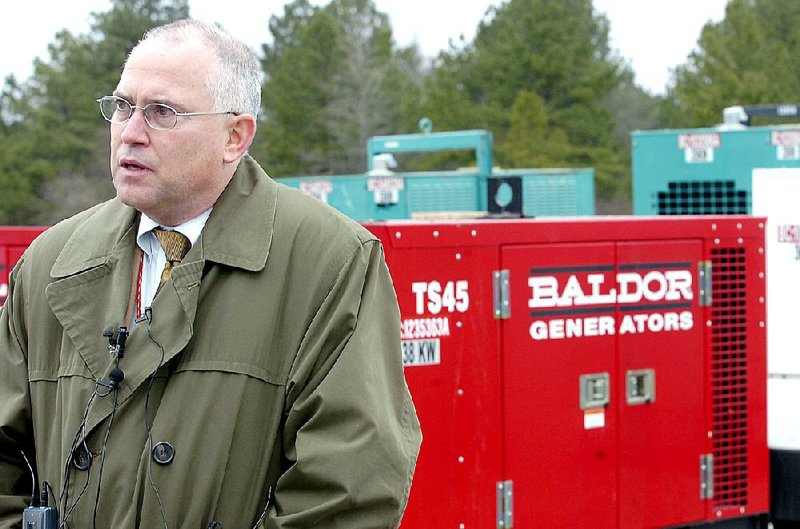When a levee breaks, David Maxwell steps in.
The veteran leader of the Arkansas Department of Emergency Management recently got a firsthand look at the havoc a failing levee can create. Floodwaters chewed away a nearly 150-yard section of an old levee in Perry County, and a feared breach in Miller County led to the evacuation of 242 people from the town of Garland.
Recent flooding throughout the state led Gov. Asa Hutchinson to declare emergencies in 37 counties, and has prompted lawmakers, Maxwell, and other state and local officials to ask: What is the state of the state's flood levees?
"I would say that it's generally unknown," Maxwell said. "Which, for a person in my position, is kind of spooky."
No one -- from the U.S. Army Corps of Engineers to state officials like Maxwell -- knows exactly how many levees there are in the state or who's responsible for maintaining them and ensuring that they are up to the task of protecting the communities as intended.
Decades of inconsistencies, law changes, court orders and poor record-keeping have created "uncertainty as to which laws govern which levee districts," according to a 2009 legislative audit report. The report stated: "Arkansas is served by a patchwork of district and privately owned levees with no central oversight of the flood control structures."
That makes it impossible to know how many levees are structurally sound and how many are just waiting to crumble, Maxwell said.
A legislative hearing on the conditions of the state's levees has been set for June 24. State Sen. Jason Rapert, R-Bigelow, said he hopes the discussion will result in some action toward accounting for the many levees in the state, and will lead to better maintenance and oversight to prevent them from deteriorating.
Rapert lives near the Perry County levee that recently was overtopped by the Arkansas River, and like many others, he saw his land swallowed up by floodwaters.
The same stretch of levee was overtopped 25 years ago, he said. State officials and the Corps of Engineers have known that the levee was inadequate but have done nothing about it, he said.
"No one took any action to raise the levee, which probably only needed to be raised a few feet to prevent this. ... It put people out of their homes, their businesses, and destroyed cropland," Rapert said. "There is no state agency that has oversight authority. ... They have ignored this situation to all of our peril, and something needs to be done."
Some levees in the state are privately owned, others are overseen by local levee districts.
After the flood of 1927, which killed as many as 1,000 Arkansans and left thousands more homeless, the state took steps toward establishing a system of levees to prevent such flooding in the future.
The Corps of Engineers built levees throughout the state and turned supervision of them over to local levee districts, which were autonomous and not subject to oversight or regulation by state or local government officials.
In fact, state law prevents the agency that's in charge of managing the state's floodways, the Arkansas Natural Resources Commission, from even listing how many levee districts or levee boards there are.
The result is a confusing network of who's responsible for them. One that's difficult to get a grip on, said Chris Villines, the head of the Association of Arkansas Counties.
"In many cases, these levee boards have been dissolved because of attrition, deaths of committee members, and no one stepped in to fill their place," Villines said. "To properly maintain levees, it takes a lot of money. Those districts, when faced with getting funds ... they can't raise the money, so they dissolve."
The Corps of Engineers has a program that can assist local levee boards. In exchange for the boards meeting levee standards and complying with levee inspections, the program allows for federal assistance in making repairs and makes nearby properties eligible for federal flood insurance.
Officials in the Little Rock Corps of Engineers district, which oversees levees along the Arkansas River and parts of the White, Little and Red rivers, said they have 68 levee districts registered with that office.
But in only half of them are levees up to code. The other "inactive" half fail to meet standards, said the district's levee safety program manager, Mark Fredricks.
"There are a few of those inactive [districts] where we know who the sponsor is," Fredricks said. "But there are some of the roughly half where you almost don't know who is in charge anymore. [The levee district] is basically defunct."
One such levee was the one that failed recently in Perry County. It was built in 1910. Floodwaters over the past few weeks swept away about a 150-yard section of it.
Tony Batey, a chief engineer with the Corps of Engineers, said that levee has been "inactive" since the late 1980s and has had no work done to it since.
"There comes a point in time where it's clear they don't want to be in the program, where no one communicates with you and it's fallen into disrepair. It doesn't make sense," Batey said. "There are many instances where people [live] in a protected area and may not be aware that they are in a protected area, and they're not aware that the levee in their area is inactive and has been allowed to fall into disrepair."
The lack of levee-board supervision can leave a levee to the mercy of the weather, foliage and even nearby construction or land alterations.
During recent flooding in Miller County, Corps of Engineers officials spotted "sand boils," or seepage areas, emerging under the levee that protects the small town of Garland from the Red River.
Larry Pritchett, an emergency management official in Miller County, said a hole dug at the base of the levee by a nearby construction project weakened the earthen structure, and it took 110 12-cubic-yard loads of sand to stabilize it.
"Had that broken under and flooded through, it would have been a catastrophe over there. Garland City would have been inundated with water ... 1,500 acres in 37 minutes at 3 feet deep," Pritchett said. "We don't know [who approved that hole being dug]. Whoever done that, it was a bad call on their behalf. ... In my opinion, that was not very bright."
To improve the condition of levees, Villines and Maxwell said the first step is to figure out how many levees there are and who is responsible for them. Given the size of the state, it is a "pretty daunting task," Maxwell said.
Villines said the Arkansas geographic information office has a map of some of the levees, but it has no information on who is responsible for them.
"I'm sure there are levees out there that have been built that have never been under control of any levee district, as well in some cases, you have areas that have a levee on them that's been unmaintained for dozens of years," Villines said. "Obviously what we're doing now isn't working."
Even after all of the state's flood-protection structures are accounted for, a more challenging problem remains.
"How are you going to fund them?" Maxwell said of levee maintenance. "There's not going to be an easy fix."
Rapert said the cost for repairing decades of neglect could be "astronomical" but that lawmakers, working with state and local officials, need to at least get the ball moving on it.
"I've been saying 'I know none of you [local and state officials] may be responsible now, but we have a responsibility to address it, because we do know there is a problem.' And what's happened is, many of them have had their heads in the sand, and nobody did anything," Rapert said. "Let's get our heads together."
SundayMonday on 06/14/2015

